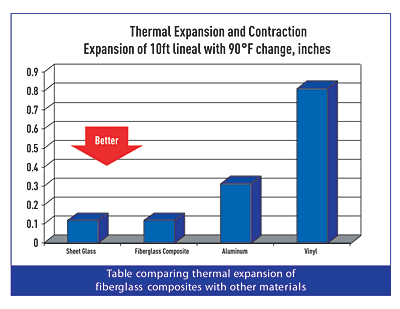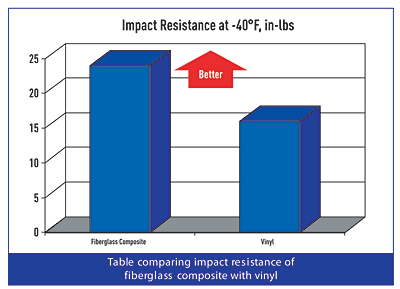Fiberglass Fenestration: A Durable, Sustainable, and Economic Alternative for Windows and Doors
|
Material Comparison Analysis
Fiberglass composites combine the best and most desirable qualities from other materials, such as durable and low maintenance aluminum, energy efficient vinyl, and wood, with its aesthetic, high performance, and environmentally friendly properties. The net result is that fiberglass composite offers the durability of aluminum, the thermal efficiency of wood, and is an economic alternative to vinyl.
The following summarizes how fiberglass composite compares to aluminum with a thermal break, and conventional vinyl, in six categories.
- Strength: In ASTM testing, fiberglass composite material has excellent ratings, twice as strong as aluminum, and eight times stronger than vinyl. Aluminum was rated very good, while vinyl rates fair, because it becomes brittle over time.
- Hot and cold performance: Fiberglass composite rates excellent because it withstands heat up to 200 degrees Fahrenheit, and cold to -40 degrees Fahrenheit. Aluminum also rates excellent, but vinyl rates fair, because it warps, sags, and softens in extreme heat; and becomes brittle in extreme cold.
- Thermal expansion: Fiberglass composite's low expansion and contraction rate (similar to glass) ensures a consistent bond between sash and glass and a weathertight fit between the sash and frame. Aluminum and vinyl are considered only fair, because their high expansion and contraction rates (which differ substantially from the glass they hold) may compromise the air and water seal between glass and frame.
- Impact resistance: Fiberglass composite ranks high, because it withstands impacts without deformation. Aluminum and vinyl are rated good and fair, respectively. Aluminum dents and vinyl shatters quickly at low temperatures. Impact resistance is important on the job site during installation, when dents and damage may inadvertently occur.
- Durability: In addition to the inherent structural qualities, certain factory-applied finishes render fiberglass composite virtually indestructible, for an excellent rating. Aluminum rates a little lower at very good, because of the potential for thermal break failure, and it is prone to corrosion on seacoast environments. Vinyl rates good, because it cannot be repaired easily if damaged.
- Energy efficiency (pertains to windows and doors with Low-E insulating glass):
Fiberglass composites rank high because of their excellent insulating properties, condensation resistance, and low U-values. (U-values are the inverse of R-values, with lower numbers indicating better insulating properties.) Aluminum rates fair, because it is a natural conductor, and a poor insulator. People seated near windows may be uncomfortable. Vinyl rates an excellent in this category.
"Fenestration is a major source of energy loss and an ongoing maintenance concern. When window products respond to these needs, along with energy efficiency and durability, while still maintaining high aesthetic standards, architects have more viable options during the design process," observes Maione.
|
For areas prone to high winds and rain, design pressure is another consideration for architects and owners. "An important criteria for me in selecting windows is the design pressure of the window," adds Brown, who chairs the AIA's Disaster Assistance program.
Fiberglass composite windows offer thermal performance that is superior to thermally-broken aluminum windows, plus design pressures up to 50 pounds per square foot (psf), the equivalent to 141 miles per hour (mph), glass not included. Strength of the glass must be calculated separately. Other design pressure technical criteria that must meet industry testing standards include structural performance, water infiltration rate, and air infiltration.











